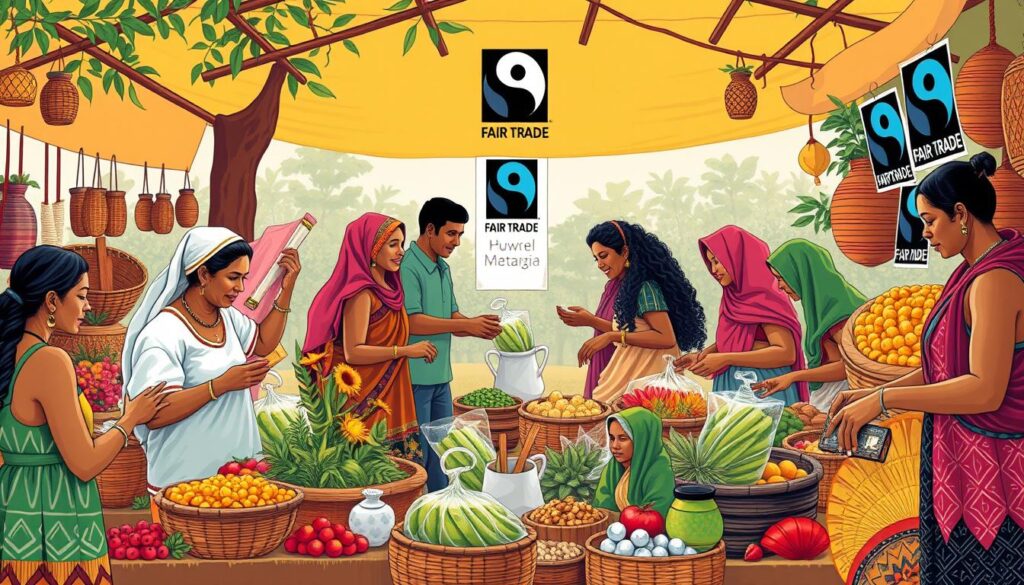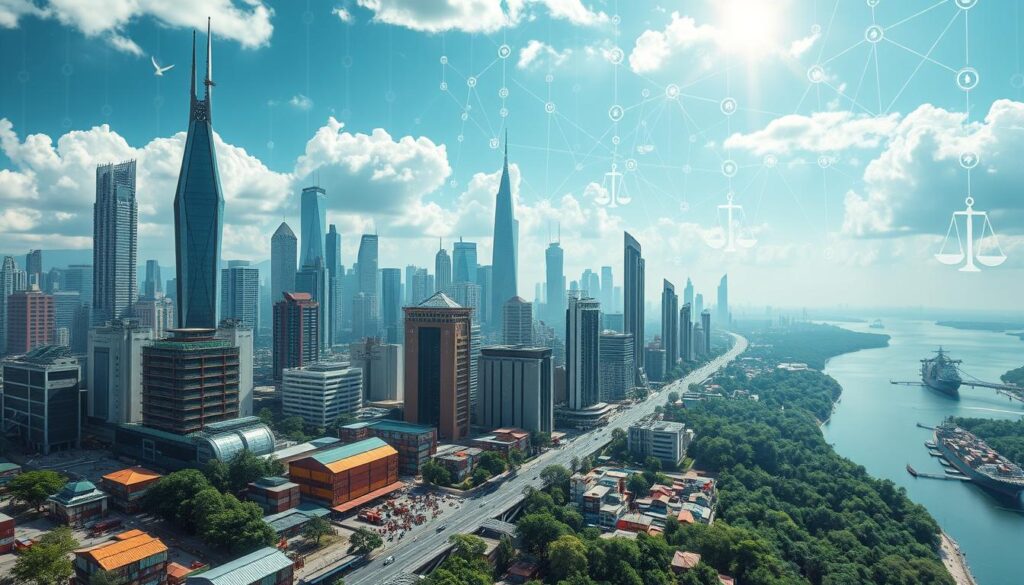International trade law and human rights are closely linked. It’s important to understand their connection to navigate global trade rules. The human rights impact of trade deals and policies can be significant. So, it’s crucial to think about these issues when making and enforcing trade laws.
As the world gets more connected, balancing trade law with human rights is more urgent. Trade rules need to support fair trade and protect human rights. They should also avoid harming human rights.
Dealing with the mix of international trade law and human rights needs a detailed approach. We must consider all involved parties and the human rights effects of trade agreements. By looking at how trade law and human rights intersect, we aim for a fairer global trade system.
The Intersection of International Trade Law and Human Rights
It’s important to understand the history of international trade law and human rights. The growth of global trade has led to a focus on human rights. Ethical trade practices are key to fair labor, environmental protection, and social responsibility.
Human rights in trade have evolved with key international frameworks. The Universal Declaration of Human Rights and the International Covenant on Economic, Social and Cultural Rights are foundational. These agreements help ensure human rights in trade.
Some notable examples of agreements that consider human rights include:
- The European Union’s Generalised System of Preferences (GSP), which offers trade incentives to countries that respect human rights and labor standards
- The United States’ Trade and Tariff Act, which includes provisions for promoting fair labor practices and human rights in trade agreements
As global trade grows, prioritizing human rights is crucial. We need to focus on ethical trade practices. This includes strong monitoring, training, and teamwork between governments, businesses, and civil society. Together, we can make sure trade agreements support human rights and sustainable development.
Understanding Global Trade Regulations in the Human Rights Context
Global trade rules greatly affect human rights. It’s key to grasp the complex ties between them. Trade law challenges come up when trade policies meet human rights. This calls for a detailed look at international law considerations.
Let’s dive into how global trade rules touch human rights. We’ll look at current trade rules and their effects on human rights.
To get a handle on trade law and human rights, here are some important points:
- Trade policies can deeply affect human rights, especially in labor and environmental areas.
- International laws, like the Universal Declaration of Human Rights, are vital in shaping trade policies and safeguarding human rights.
- For trade law and human rights to work well, governments, international groups, and civil society must work together.
Looking at where trade policies and human rights meet helps us understand trade law challenges. It shows the importance of thinking about international law considerations. This knowledge is crucial for advancing human rights and making sure global trade rules are just and fair.
The Impact of Trade Agreements on Human Rights Protection
Trade agreements greatly affect human rights, especially in labor, environment, and indigenous rights. It’s key to include human rights in these agreements. This ensures trade promotes rights, not harms them.
Some trade agreements help human rights, while others hurt them. Agreements with labor and environmental standards help. But, those that focus on money over rights can be bad.
Labor Rights and Working Conditions
Labor rights are vital. Trade agreements should protect these rights, like the right to bargain and not be forced to work. The International Labor Organization (ILO) has rules for this. Trade agreements should follow these rules.
Environmental Protection Standards
Environmental protection is also key. Trade agreements should help protect the environment. This includes reducing pollution and saving natural resources. The Paris Agreement is a good example. Trade agreements should match its goals.
Indigenous Peoples’ Rights
Indigenous peoples’ rights are also important. Trade agreements should protect their rights, like self-determination and cultural preservation. The United Nations Declaration on the Rights of Indigenous Peoples guides this. Trade agreements should follow its lead.
In summary, trade agreements greatly impact human rights. It’s crucial to include human rights in these agreements. By focusing on labor, environment, and indigenous rights, we can make the world more just and fair.
Ethical Trade Practices: Bridging the Gap
Companies like Patagonia and REI focus on ethical trade practices. They aim to close the gap between international trade laws and human rights. By doing so, they show their dedication to corporate social responsibility.
Some important practices for ethical trade include:
- Fair labor conditions
- Environmental sustainability
- Community engagement
These actions help ensure human rights compliance. They also boost a company’s image and support corporate social responsibility.

By embracing ethical trade practices, companies can make sure their work meets human rights compliance standards. This helps create a fairer and more responsible global trade system. It’s key for promoting corporate social responsibility and making a positive difference in the environment and society.
Challenges in Implementing Human Rights in Trade Law
Putting human rights into trade law is hard. One big problem is the lack of strong enforcement mechanisms. This makes it hard to know which laws to follow.
Some big challenges include:
- Weak enforcement mechanisms that don’t punish companies and governments for wrongs
- Jurisdictional issues that confuse which laws apply
- Not enough transparency and accountability in trade deals
To solve these challenges in implementing human rights, we need to work together. Governments, companies, and groups like Amnesty International must join forces. Together, we can make sure human rights are respected in trade law.
Case Studies: Successful Integration of Human Rights in Trade
Real-life case studies show how human rights in trade can work well. They share the best ways and the hurdles faced. By looking at these examples, we learn what makes human rights in trade successful.
Some examples stand out:
- Trade deals that include labor and environmental rules
- Companies that focus on human rights in trade through clear supply chains and fair work
- Projects that help people understand and support human rights in trade through education
These case studies show why human rights in trade matter. They prove that working together and sticking to ethical trade is key to success.
The Role of International Organizations and NGOs
International organizations and NGOs are key in making sure human rights are part of trade laws. The World Trade Organization and the United Nations have set up rules to keep trade fair. They help countries follow these rules to protect human rights.
The World Trade Organization focuses on making sure trade is fair. The United Nations has its own guidelines for human rights in trade. NGOs, like human rights groups, also push for these rights in trade.
Key Initiatives
- World Trade Organization’s guidelines for human rights in trade
- United Nations’ guidelines for human rights in trade
- NGOs’ initiatives to advocate for human rights in trade
International groups, NGOs, and the World Trade Organization are teaming up. The United Nations is also key in setting human rights guidelines for trade. Together, they aim to make sure trade respects human rights and is fair for everyone.
Future Trends in Trade Law and Human Rights Protection
Looking ahead, we must think about how new technologies will shape trade law and protect human rights. The use of future trends in trade law will be key in the global economy and human rights. New tech like artificial intelligence and blockchain can make trade more transparent and accountable.
The United Nations’ sustainable development goals will guide trade law and human rights. These goals focus on fair work, less inequality, and responsible consumption. This will help make global trade fairer and more just. Key areas to focus on include:
- Using tech to track and monitor human rights abuses in supply chains
- Creating sustainable trade practices that protect the environment and society
- Boosting international cooperation to tackle new tech challenges
By using emerging technologies and focusing on sustainable development goals, we can build a better future. It’s important to keep up with future trends and their effects on the global economy and human rights.

Best Practices for Companies and Governments
Ensuring human rights in trade is key for companies and governments. It’s vital to follow best practices that put human rights first. Conducting human rights due diligence is a must to spot risks and act on them. This means checking the human rights impact of trade and planning how to fix issues.
Companies and governments should also engage with stakeholders like local communities and NGOs. This builds trust and makes sure trade matches human rights standards. Plus, ethical trade practices stop human rights abuses and support fair work.
- Developing and implementing human rights policies and procedures
- Providing training on human rights for employees and stakeholders
- Conducting regular human rights audits and assessments
- Engaging with stakeholders to promote human rights and address concerns
By sticking to these practices, companies and governments can make sure their trade respects human rights. This helps create a fairer and more just global trade system.
Conclusion: Towards a More Balanced Future
As we wrap up our look at international trade law and human rights, it’s clear we need a balanced approach. We’ve seen how trade rules and human rights have evolved over time. We’ve also looked at the challenges in combining these two important areas.
Going forward, governments, international groups, and businesses must work together. They should aim to balance global trade with protecting human rights. By supporting sustainable development goals and ethical trade practices, we can build a fairer future. This future will have economic growth and human dignity working together.
We need to keep researching, talking openly, and being accountable. This way, we can manage the mix of trade law and human rights well. We can make sure economic growth doesn’t hurt basic human freedoms and dignity. By taking a complete view, we can make a world where trade and human rights support each other. This will help businesses and the world at large.
FAQ
What is the historical development of international trade law?
International trade law has a long history, starting with ancient civilizations. It grew with trading networks. The 20th century saw big changes with agreements like the General Agreement on Tariffs and Trade (GATT) and the World Trade Organization (WTO).
How have human rights been integrated into the global trade system?
Human rights in global trade have grown slowly. Now, trade policies must respect basic rights like labor and environment. The United Nations Guiding Principles on Business and Human Rights help guide this effort.
What are some key challenges in implementing human rights in trade law?
Challenges include enforcing rights and dealing with jurisdiction. It’s also hard to balance business needs with human rights. Trade agreements often face these tough choices.
How have successful companies and governments integrated human rights into their trade practices?
Some companies and governments have made progress. They do human rights checks, follow ethical sourcing, and work with civil society. Transparency and continuous improvement are key.
What is the role of international organizations and NGOs in promoting human rights in trade?
Groups like the World Trade Organization and the United Nations set guidelines. NGOs push for stronger rights, monitor, and help develop ethical trade policies.
What are some future trends in the intersection of trade law and human rights?
New tech and sustainable goals will shape trade law and human rights. These changes offer chances and challenges for aligning trade with human rights and sustainability.

